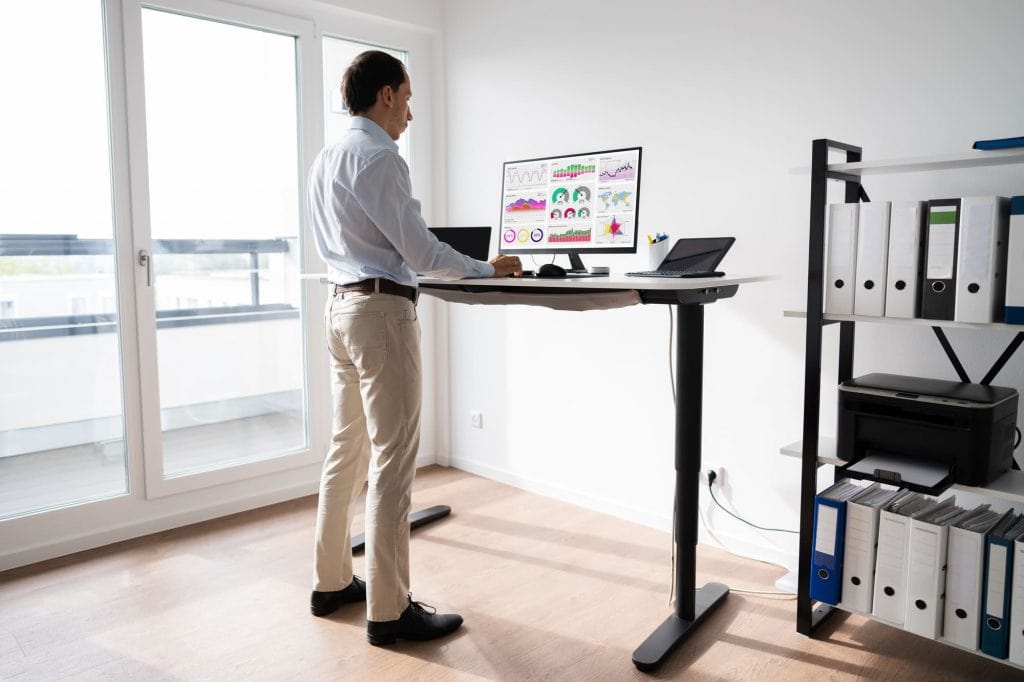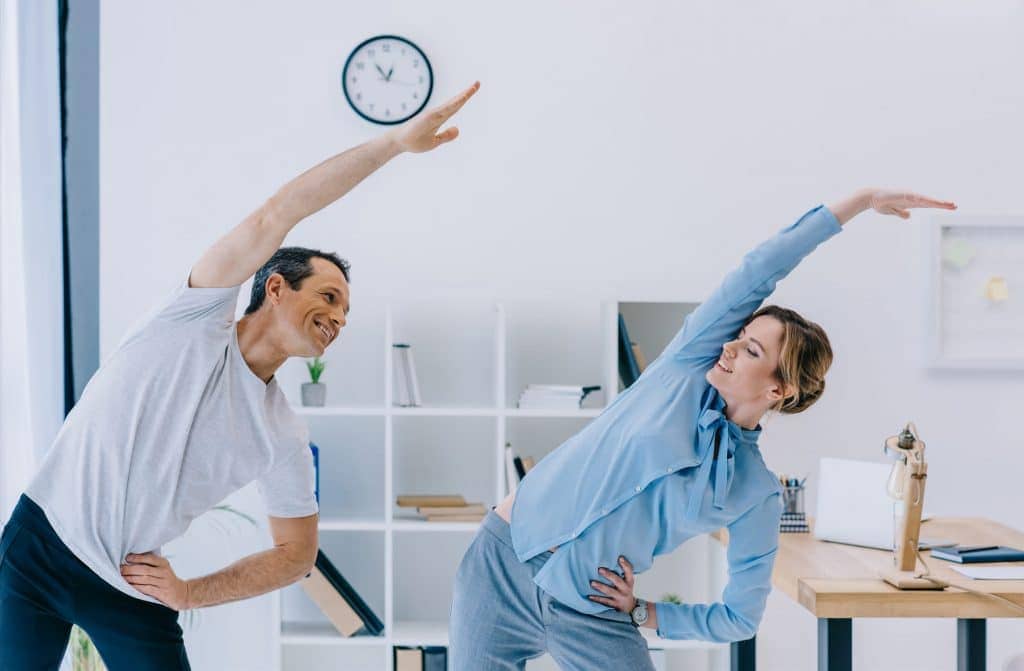*When you buy through links on our site, we may earn an affiliate commission at no additional cost to you.
The ugly side of using a standing desk is that prolonged standing can cause strain and pain in your feet. That’s why you’re recommended to not stand for too long and not to entirely ditch your office chair at your workplace.
As this Canadian Centre for Occupational Health and Safety (CCOHS), 2014 report suggests, long periods of standing at work can result in sore feet.
It causes pooling of blood in your legs —significantly increasing the risk of varicose veins!
This guide sheds more light on how standing workstations damage your foot and key measures you can put in place to keep your foot happy and healthy while using your standing workstation.
Table of Contents
What causes foot pain while using your standing desk?

As we have just mentioned above, a standing desk can affect the health of your feet. But how exactly does standing desk foot pain occur? This is what we’ll be discussing below…
Poor circulation of blood
When you stand at your desk for long periods of time, especially on a hard floor with bare feet or with inappropriate footwear, your heels become fatigued and sore.
This is because the solid surface (which can be carpeted or concrete) doesn’t promote any tiny movement of your foot and ankles, thus keeping them trapped in place.

This leads to inadequate circulation of blood in your feet, resulting in inflammation which then leads to issues like soreness, fatigue, and soft tissue injury.
Overworking your leg muscles
When you stand for long hours, you are also forcing your foot muscles into a position where they must keep working constantly to keep you supported and stabilized.
As these same muscles keep working continually to keep you in the stationary position, they get easily fatigued and inflammation can occur.
Pressure buildup

Standing in the same position for long, without any movements, will cause persistence of pressure on one spot on your feet.
This usually happens at the heels as they tend to take most of the weight while you’re standing.
This translates to pressure points that cause staining in the muscles and joints in the specific spot on your foot and discomfort is inevitable.
Bearing the burden of your body weight
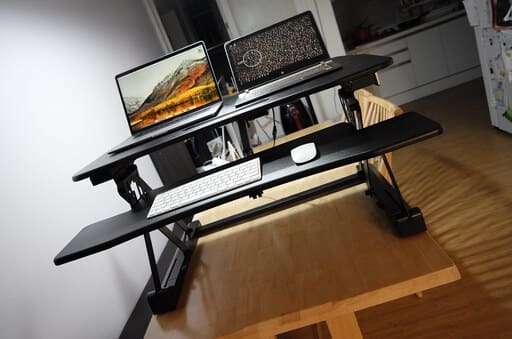
You should also keep in mind that when you’re standing, your lower leg, heel, and foot are responsible for carrying the brunt of your body weight. As a result, the muscles and joints quickly grow tired.
The foot is made up of dozens of joints tendons, ligaments, and bones which can get easily strained and get hurt by long periods of standing.
IMPORTANT: Long standing hours cause not only your heels to become sore and painful but serious health issues like plantar fasciitis (a strain on the plantar fascia, a tendon at the bottom of your foot that results in heel pain) and varicose veins.
How do you prevent foot pain when using standing desks?
You can keep your feet healthy and pain-free by implementing various tips and tricks when using your sit-stand desks. In this section, we discuss these top tips to eliminate foot pain caused by sit-stand desks.
Ease your way into standing desks

One of the things people do wrong when they’re new to standing desks is spending long hours straight standing.
This is a bad idea for a newbie because your body isn’t yet used to standing for hours and you risk getting sore foot and whole body discomfort.
Remember, standing demands a great deal of muscular strength in various areas of your body. And this strength and endurance take time to develop.
So, how much time should you spend standing at your stand-up desk?
We recommend standing for 15-30 minutes (or half hour) every hour on your eight-hour workday. This can go for on about a week.
You can gradually increase the standing duration as your body gets used to it. Soon you’ll be standing for hours without your getting your feet hurt or suffering whole-body discomforts.
Don’t stay in standing position for too long
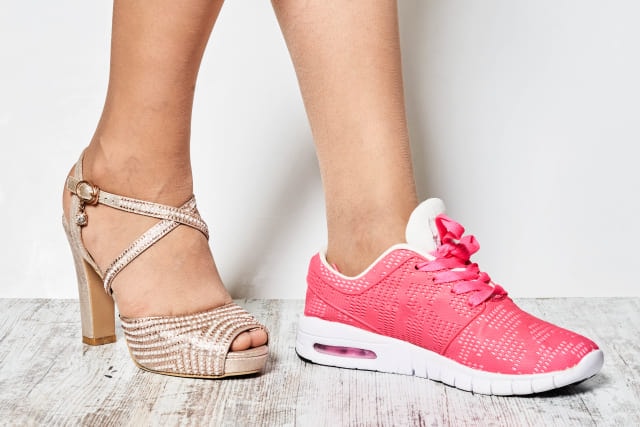
Another way to keep your foot from getting hurt is alternating between sitting and standing positions. After all, sitting isn’t harmful to you (too much sitting time is what you should avoid).
Most office workers who are new to these desks believe they should excessively stand at them to beat a sedentary lifestyle and the dangers it comes with.
But the truth is that moderation is what will help you reap the full health benefits of standup desks.
Frequent transitions between sitting and standing positions to avoid subjecting your leg muscles and foot to unnecessary straining caused by extended standing.
Switching between these postures allows movements in your muscles and improves circulation.
If possible, try to get a few moments to take quick walks in between the sitting and standing sessions as another way to prevent foot discomfort (read more details in our next tip).
Move your body
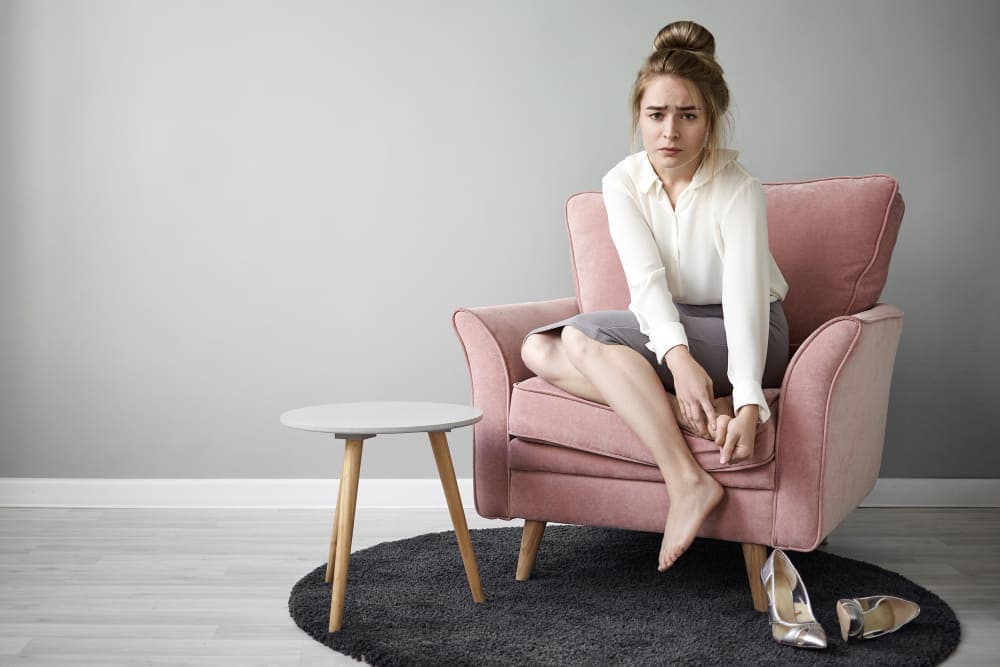
When you stand in the same position for too long, pressure starts building up in your lower legs and feet.
This eventually leads to the accumulation of static pain. However, moving around or taking quick walks will help prevent pressure points and keep fluids in your body in motion.
We suggest taking a few minutes each working hour to move around. This is a good way to give your body a break from standing to keep your leg muscles active and engaged.
Taking quick walks to the restroom or water cooler, are some of the ways you can take a break from the standing position.
You can also move by swinging back and forth at your standing desk, switching positions using your feet, shifting from your foot ball to your heel (and repeat), etc. And avoid locking your knees.
Say NO to poor posture
Standing with a bad posture will cause lower and upper back pain, knee pain, and even hip pain. Poor posture while sitting, on the other hand, will cause neck pain, shoulder pain, and back pain.
Since all the muscles in the human body are somehow interconnected, getting into the proper posture can also help prevent foot discomforts.
Good posture will make your body’s weight get uniformly distributed and decrease or even prevent foot pain and strain from occurring in the first place.
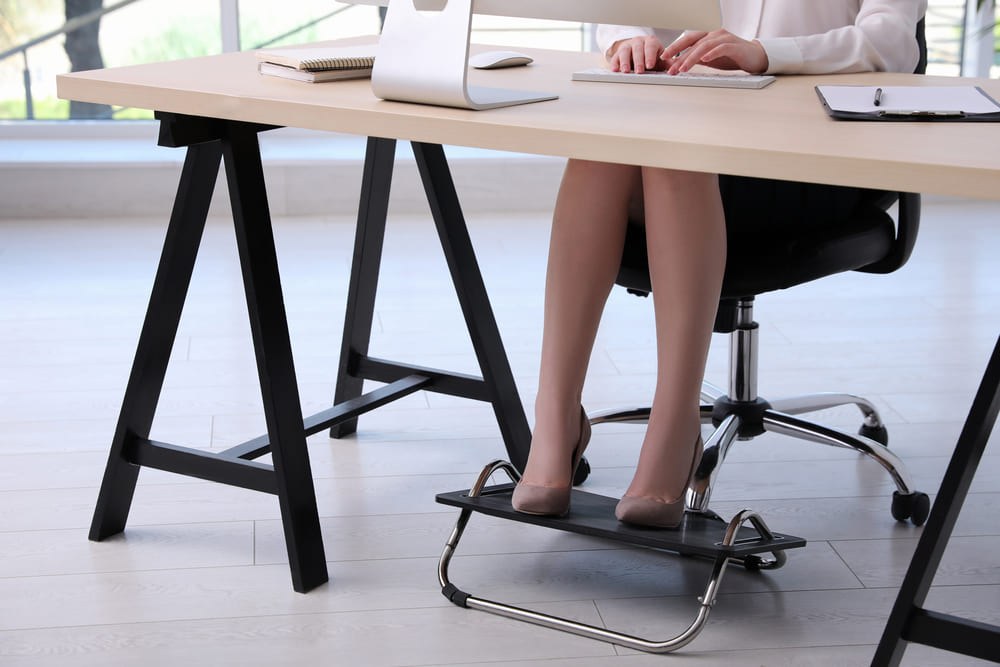
That being said, you want to ensure you get in the right upright position when using your standing desk. This becomes easy if you set your computer monitor at eye level and tilt it up a bit.
You should also adjust your desk height such that your arms rest on its work surface at around 90 degrees angle to the floor.
Avoid slouching and engage your core muscles to help support your back. Make sure your feet are shoulder-width apart, your ribcage above the hips, and your shoulder rolled back and relaxed.
That’s how you get in the correct standing posture!
Stretch more often

Long standing hours cause muscle strain, especially in your feet and lower limbs. This is because these muscles are unable to hold on for too long and will end up getting strained.
Moreover, staying on your feet for long tends to shorten and tighten your leg muscles over time.
Luckily, stretching your legs regularly can help keep these muscles flexible, greatly increase your endurance, and prevent the risk of foot soreness and pain.
You just need to engage your legs in simple stretches and you don’t even need to move away from your workstation. You can also do these stretches when you take a break from a standing or sitting session
Here are some examples of simple stretches for a healthy foot:
- Toe stretch
- While in the seated position, put one leg over the other.
- Then, grab your toes with one hand and gently pull them in your direction, and release
- Hold each pull for approx. 30 seconds
- Towel stretch
- This is a good exercise for stretching your feet and calves.
- You simply sit down with your legs straightened out in front of you.
- Then, place a towel around the toes and gently pull it in your direction while keeping the legs straight.
- Hold this position for 15-30 seconds and repeat another two times. You should be able to feel your toes and calves stretch.
- Step Stretch
- You can do this stretch by standing on a step such that your heel hangs at the edge
- Lower the heels slowly until you feel your calves stretch
- Hold this for 10-20 seconds before raising your foot up level again
Repeat this stretch 3 times
- Lacrosse ball roll
- Rolling your foot back and forth or in circles on a lacrosse ball or tennis ball can also help. Do the rolls for approx. 5 minutes on each foot.
- This exercise is a great way to massage the bottom of your foot, improving blood circulation and easing tendon and muscle pain.
Get an anti-fatigue mat
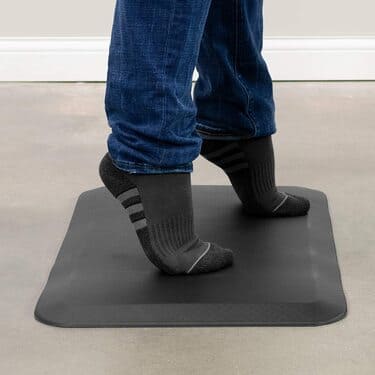
An anti-fatigue mat, also known as a standing mat, is a great accessory that will help minimize foot damage and pain while using your sit-or-stand workstation.
It simply adds cushioning to any type of floor (this is especially helpful for hard floors, like carpet floors, which are bad for prolonged periods of standing).
The mat keeps you off balance, forcing your foot to make micro-movements in an attempt to keep you balanced. And in so doing, it helps reduce pressure buildup and improve blood circulation.
Mind you, professionals whose occupations involve staying on your feet for too long have been using these anti-fatigue mats to take the pressure off their feet and keep them comfortable for long hours of standing.
Examples include hair stylists, bank tellers, and chefs.
Gladly, there are many mat options out there, so finding a quality one that meets your needs shouldn’t be a problem.
Get the right footwear
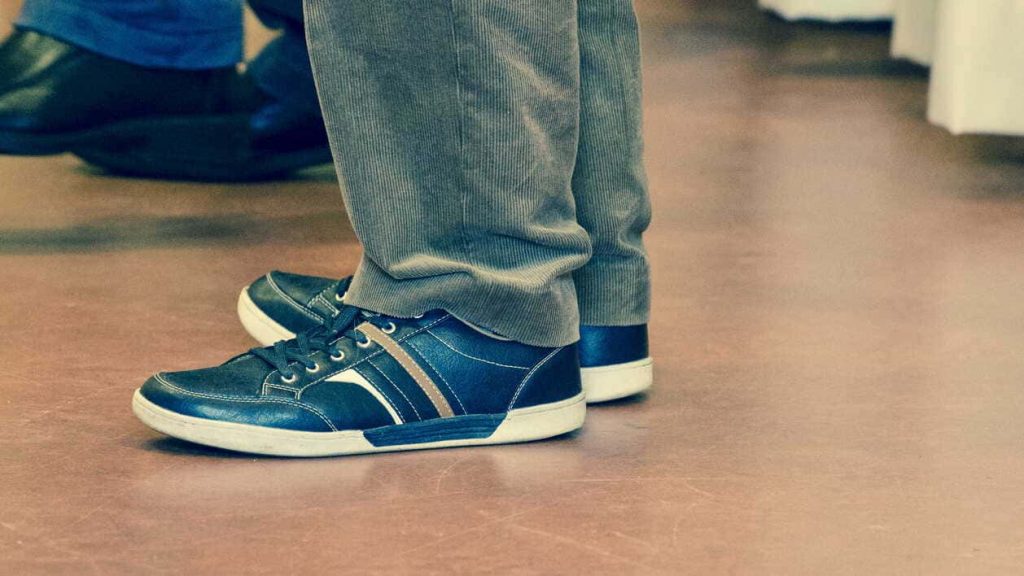
If you’re serious about keeping your foot healthy at your sit-stand workspace, you should also consider getting the right type of shoes.
Most WFH (work from home) folks will typically stand at their standing desks barefoot, or wear slippers or socks. This may seem comfortable at first but it is never a good idea if you’re using your standup workspace for long hours.
We advise you to wear shoes that are more supportive to save your lower limbs from unnecessary torture and pain. There are specific stand-up desk shoes, so the right pair for you will depend on your foot as well as your unique needs.
Some office workers put on running shoes with supportive arches and they work just fine. Others prefer shoes that provide their feet with more cushioning.
For folks experiencing heel pains, it’s best to go for footwear specially made for properly cushioning your heels.
If you suffer from high arches or any other form of arch pain, get shoes whose insole is optimized to offer you more arch support.
Final Word – Can A Standing Desk Damage Your Feet?
While standing desks are a great way to keep you healthy at work, using them for prolonged periods of time can hurt your feet. Extended standing sessions strain your muscles and make them get quickly fatigued and even make them sore.
We have discussed the key tips for preventing foot discomfort while using your standing desks. These include regularly alternating between sitting and standing, moving more often, maintaining correct posture, and stretching your body.
Getting a standing mat and wearing the right shoes can also help prevent foot pain.
Implement these simple tips today and you’ll be able to get all the benefits offered by your stand-up workstation without hurting your foot health.

